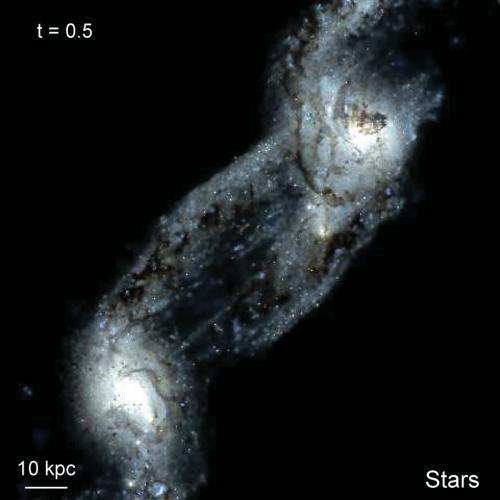Modeling galaxy mergers

(Phys.org) —Astronomers think that many galaxies, including our own Milky Way, have undergone similar collisions during their lifetimes. Although galaxy collisions are important and common, what happens during these encounters is not very well understood. For example, it seems likely that massive black hole(s) will form during the interactions, as the two galaxies' nuclei approach each other. Galaxy-galaxy interactions also stimulate vigorous star formation as gravitational effects during the encounters induce interstellar gas to condense into stars. The starbursts in turn light up the galaxies, especially at infrared wavelengths, making some systems hundreds or even thousands of times brighter than the Milky Way while the starbursts are underway. Studying these luminous galaxies not only sheds light on how galaxies evolve and form stars, since they act as lanterns over cosmological distances it also helps scientists study the early universe.
All this impressive progress, however, hinges on an accurate understanding of mergers and how they work. The general approach is to study many local examples to categorize their behaviors, and then model these cases with computational codes that simulate mergers. The combination of precise observations and detailed modeling, iteratively applied, helps scientists improve both their understanding of the galaxies and the physical parameters and processes included in the modeling codes. With these in hand, astronomers can start to probe the more distant universe where the objects are not as easy to measure.
CfA astronomer Lars Hernquist and five of his colleagues (many of whom were his past students) have now shown that feedback processes from bursts of star formation play a key role in determining how merging galaxies develop, at least when two massive galaxies collide. Prior models did not fully account for the role played by gas that is driven away by the radiation from a star burst, but which can sometimes fall back the galaxy. The new paper is particularly effective in describing star formation in the tails and bridges of interacting systems, something had previously been lacking.
Provided by Harvard-Smithsonian Center for Astrophysics





















